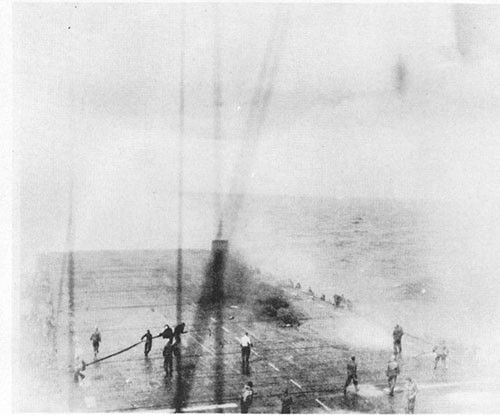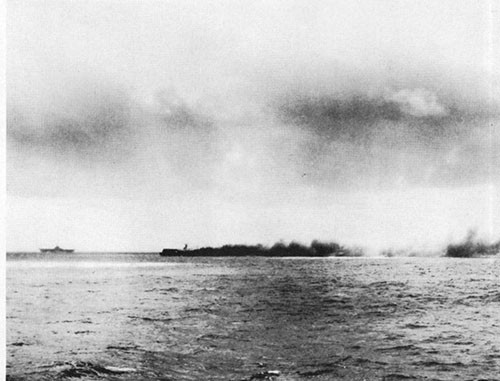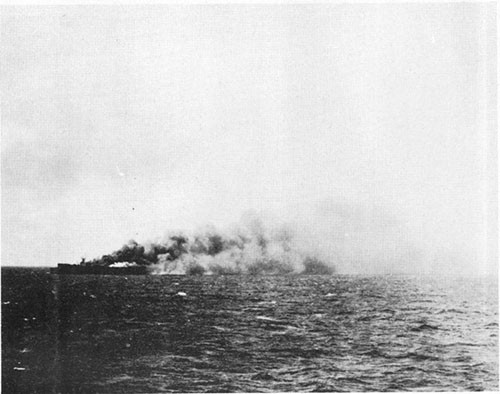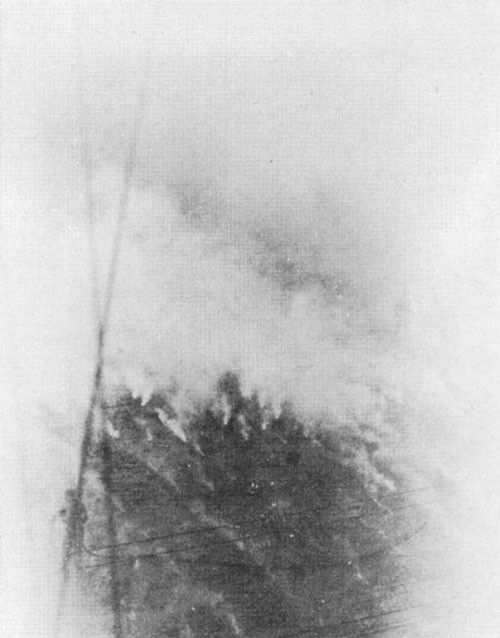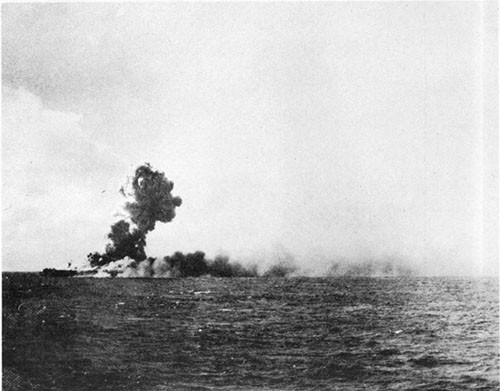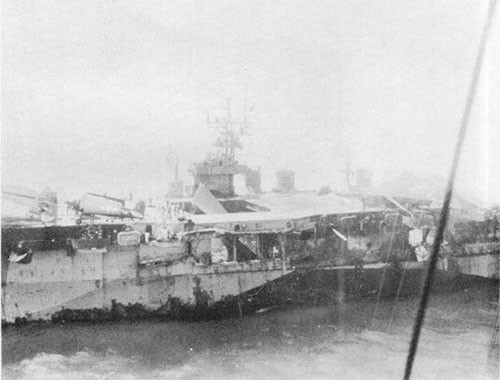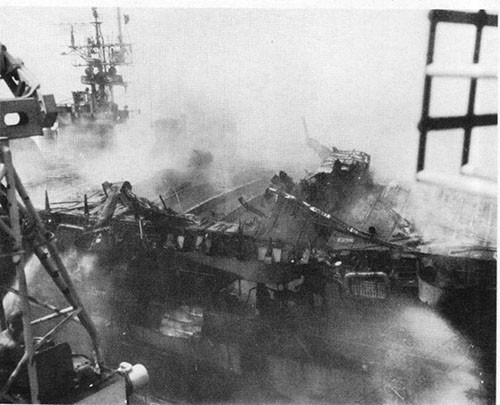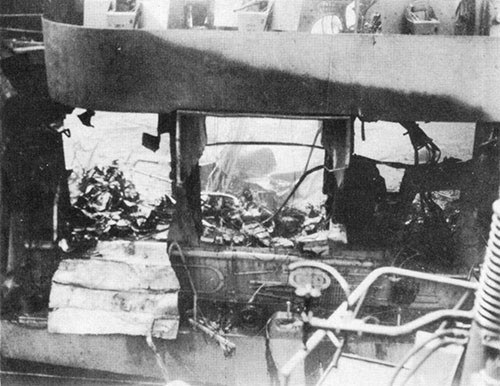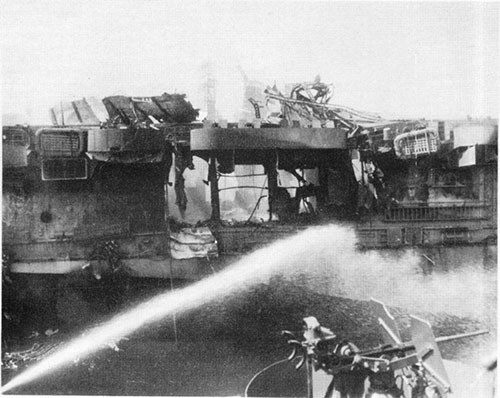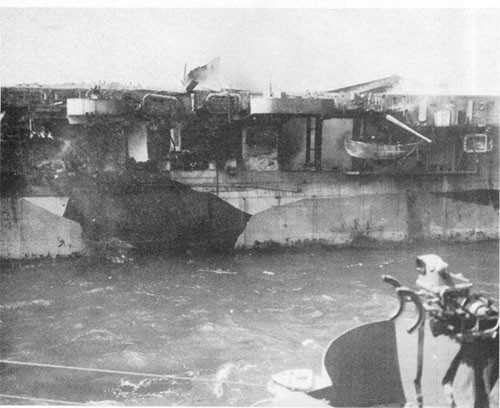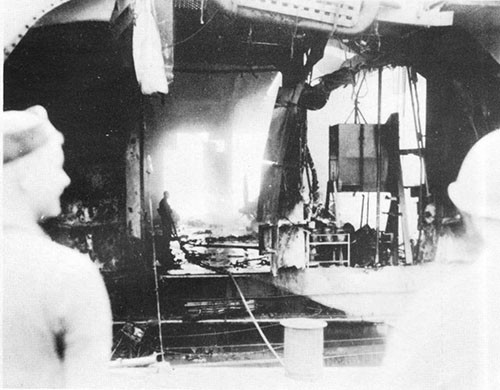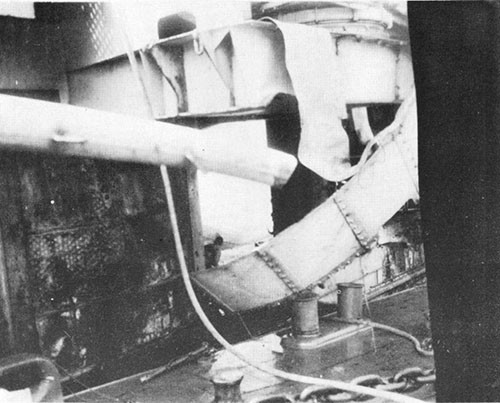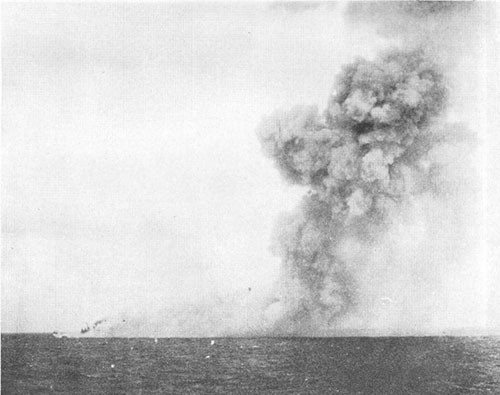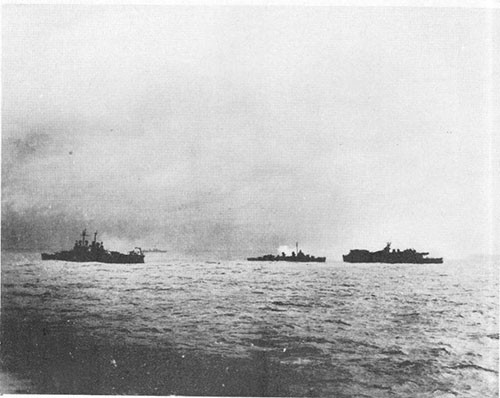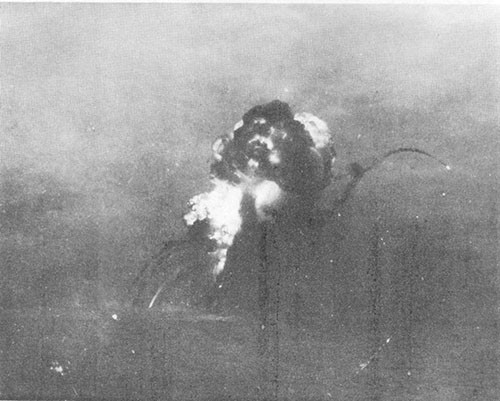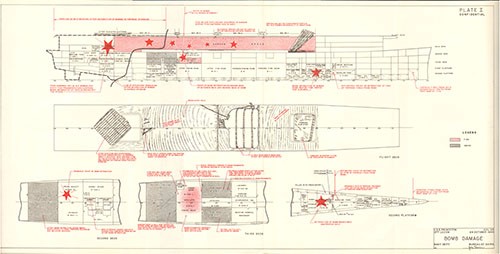
The Navy Department Library
U.S.S. Princeton (CVL23)
Loss in Action
Battle for Leyete Gulf
24 October 1944
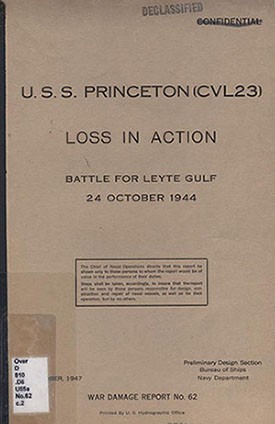
CONFIDENTIAL
U.S.S. Princeton (CVL23)
Loss In Action
Battle for Leyte Gulf
24 October 1944
The Chief of Naval Operations directs that this report be shown only to those persons to whom the report would be of value in the performance of their duties.
Steps shall be taken accordingly to insure that the report will be seen by those persons responsible for design, construction and repair of naval vessels, as well as for their operation, but by no others.
Preliminary Design Section
Bureau of Ships
Navy Department
30 October, 1947
WAR DAMAGE REPORT No. 62
Printed By U. S. Hydrographic Office
U.S.S. PRINCETON (CVL23)
Loss in Action Off Luzon
24 October 1944
| Class | Aircraft Carrier Small | Length (W.L.) | 600 Ft. 0 In. |
| Launched | 18 October 1942 | Beam (W.L.) | 71 Ft. 6 In. |
| Displacement (Full Load) | 15,120 tons | Draft (Mean Full Load) | 24 Ft. 8 In. |
References:
(a) C.O. PRINCETON ltr. CVL23/A9/A16-3, Serial (020) of 24 November 1944.
(b) C.O. BIRMINGHAM ltr. CL62/L11-1/L9-3, Serial 0050 of 10 November 1944.
(c) C.O. IRWIN ltr. DD794/S93, Serial (0056) of 27 October 1944.
(d) C.O. RENO ltr. CL96/A16-3, Serial (067) of 30 October 1944.
CONTENTS
SECTION |
Page |
|
| I - | SUMMARY | 1 |
| II - | NARRATIVE | 2 |
| III - | DISCUSSION | 7 |
| A. Bomb Damage | 7 | |
| B. Fires and Explosions in Hangar | 8 | |
| C. Firemain System | 10 | |
| D. Hangar Sprinkling | 12 | |
| E. Machinery Damage | 14 | |
| F. Explosion of Bombs in Torpedo Stowage | 15 | |
| G. Explosion of Forward Magazines | 16 | |
| H. Conclusion | 17 |
--i--
LIST OF PHOTOGRAPHS
| No. | TITLE |
| 1 | Black smoke emerging from bomb hole in flight deck. |
| 2 | PRINCETON about two minutes after bomb hit. Note smoke on the port side which was drawn into the engineering spaces through the ventilation supply intakes. |
| 3 | PRINCETON at about 0953. Fire raging aft. Ship has turned to put wind 45 degrees on port bow. Smoke appears to be blowing clear of the ventilation supply intakes on the port side. |
| 4 | Flight deck smoking before first major explosion in hangar. |
| 5 | First major explosion in hangar at 1002. |
| 6 | General view of forward damage from explosions in hangar. Note beam on flight deck crane, inclined forward elevator platform, hole blown in flight deck and panels blown out on the port side of the hangar. |
| 7 | Close-up-view of hole in flight deck between frames 68 and 80. Note transverse bents still intact but bowed upward. |
| 8 | View of damage to hangar deck seen through blown-out side of hangar. Note crumpled area of hangar deck centered at about frame 78. |
| 9 | View of damage to port side of hangar between frames 74 and 86. Note similar damage to starboard side of hangar. |
| 10 | View of damage to after end of flight deck as a result of explosions in hangar. Note overturned elevator platform. |
| 11 | View of after port side of PRINCETON. Note hangar roller curtains demolished, panel between frames 110 and 113 blown out and hole in panel between frames 115 and 118. |
| 12 | Close-up view of port side showing hangar roller curtain opening between frames 107 and 110 and blown-out panel between frames 110 and 113. Note similar damage to starboard side. One of the two airplane engines not consumed by the fire or demolished by the explosions in the hangar can be seen. |
--ii--
| 13 | Hole blown in hangar deck at about frame 114. Gun sponson was damaged by ships alongside. |
| 14 | Smoke from detonation of bombs stowed in torpedo stowage. BIRMINGHAM visible at left edge of smoke. |
| 15 | PRINCETON after detonation of bombs in torpedo stowage. |
| 16 | Explosion of forward bomb magazines initiated by torpedo hits. PRINCETON had sunk by the time smoke cleared. |
--iii--
SECTION I - SUMMARY
1. PRINCETON (CVL23) was hit by an estimated 250 kg. GP bomb on the morning of 24 October 1944 while participating in the Battle for Leyte Gulf off the coast of Luzon about 150 miles east of Manila. At the time of the attack, enemy action was expected and the ship was at General Quarters with Material Condition ABLE set. Planes were being recovered and refueled and six torpedo planes, loaded with torpedoes and fully gassed, were spotted in the hangar ready for a scheduled strike.
2. At 0938 a single enemy plane scored a bomb hit about 15 feet off the centerline to port at frame 98 on the flight deck. The bomb passed through the flight deck, went through a torpedo plane on the hangar deck, pierced the hangar and main decks, and detonated in B-204-2L on the second deck or between the main and second decks. The resulting structural damage was relatively minor.
3. In the hangar a gasoline fire started immediately in the wreckage of the plane through which the bomb passed. The fire spread rapidly. By 0953 the entire hangar was ablaze. Difficulties were encountered in turning on the hangar sprinkling bays and water curtains; only one of the four hangar sprinkling bays and one of the three water curtains were reported as being definitely turned on and there was no report of anyone actually seeing these sprinklers in operation. The after fireroom and engineroom were abandoned almost immediately due to heat and smoke. This resulted in loss of firemain pressure aft within three minutes after damage was received. Except for a break in a high pressure air line in the after engineroom, there was no derangement of machinery in the engineering spaces.
4. Between 1002 and 1020 there occurred a series of heavy explosions in the hangar. Some of the torpedo warheads in the planes were roasted and may have detonated or gasoline vapor may have exploded violently. These explosions blew up the flight deck, wrecked both elevators, and forced evacuation of all machinery spaces. All firemain pressure was lost at 1010. As a result of the explosions, the Commanding Officer ordered Salvage Control, Phase I at 1010 followed by Salvage Control, Phase II at 1020.
5. After 1010 the fire in the hangar was fought with the aid of BIRMINGHAM, RENO, IRWIN and MORRISON. By 1330 the fires were almost under control. The only known remaining fire was centered around the torpedo workshop and after elevator pit.
6. Unfortunately, at 1330, both BIRMINGHAM and MORRISON, the only ships aiding PRINCETON at the time, pulled clear in a great hurry because of submarine and enemy plane contacts. The fire blazed up with renewed vigor.
7. As the attack did not develop, BIRMINGHAM began maneuvering to return alongside to port of PRINCETON. While BIRMINGHAM was coming alongside at 1523, there was a terrific mass detonation of four hundred 100-pound GP bombs stowed in the torpedo stowage C-101B which blew off the entire stern aft of frame 120 and the structure above
--1--
the main deck from frame 120 forward to frame 105. Casualties aboard BIRMINGHAM were extremely high and casualties among the personnel on PRINCETON were severe. Almost all casualties were caused by fragments. In spite of the extensive damage done by this tremendous detonation, there was no noticeable change in list or trim of PRINCETON.
8. After the detonation, PRINCETON was abandoned and, because of the tactical situation, was sunk by our own forces. A torpedo from RENO mass detonated the bomb magazines forward and PRINCETON sank in less than one minute.
9. PRINCETON is considered to have had a well developed firemain system with ample pumping capacity. The inability to control the fire in the hangar is disappointing in view of the intact condition of the pumping plant and the relatively small amount of damage resulting from the bomb hit. Failure to immediately control this fire resulted in a series of major explosions in the hangar, some possibly produced by the detonation of torpedo warheads, and later in the mass detonation of bombs in the torpedo stowage which forced PRINCETON to be abandoned. It was unfortunate that the threat of attack required BIRMINGHAM to leave PRINCETON at 1330 when the fires were so nearly extinguished.
10. The stowage of bombs in the torpedo stowage was a major factor in PRINCETON's loss. This space was not designed to carry explosives. It did not have the protective features of a magazine and its use for carrying bombs required the acceptance of considerable risk.
11. Even after the explosion of the bombs in the torpedo stowage, the ship was apparently still seaworthy but damage received by the escorting ships and the tactical situation precluded further salvage efforts.
SECTION II - NARRATIVE
12. On the morning of 24 October 1944, PRINCETON was a unit of a Fast Carrier Task Group, composed of two ESSEX Class Carriers and two CVL's, supporting battleships and cruisers and screening destroyers. The group was approximately 150 miles east of Manila at dawn.
13. At 0520 PRINCETON went to General Quarters and set Material Condition ABLE. Planes had been gassed and armed during the night preparatory to launching an attack group scheduled at 0900.
14. PRINCETON launched eight fighters for combat air patrol at 0610. A large group of enemy aircraft was detected at 0750 and PRINCETON was ordered to launch three additional divisions of fighters. Two large air engagements ensued between 0750 and 0845.
--2--
15. Meanwhile an enemy naval force had been located and preparations were made to launch the scheduled strike which was to include 8 fighters and 9 torpedo planes. At about 0900 PRINCETON commenced recovering fighters which were required to escort the attack group and at 0910 the gasoline detail commenced fueling planes that had just landed. To clear the flight deck sufficiently for landing planes, 6 of PRINCETON's loaded torpedo planes were moved to the hangar deck where they were spotted in a fore and aft line on the port side. These planes were each armed with one Mark 13, torpex-loaded torpedo and were fully gassed including auxiliary wing tanks. Ten fighter planes were recovered and two more were about to land when the bomb hit.
16. The firemain had been divided into three sections by closing valves in the port and starboard main at frames 68 and 99 and fire hoses had been led out on the hangar and flight decks. The hangar sprinkling pumps were in condition to be started by remote control. The hangar sprinkling loop on the third deck was not divided.
17. At 0938 a single Japanese bombing plane Type JUDY dived out of a low cloud cover ahead of PRINCETON and scored a bomb hit about 15 feet to port of the centerline at frame 98 on the flight deck. The bomb passed through the flight deck, leaving a hole between 14 and 16 inches in diameter, went through a torpedo plane on the hangar deck, pierced the hangar and main decks and detonated in B-204-2L on the second deck or just above that deck. The detonation of the bomb caused very little jarring on the bridge, and was felt as a dull jar in central station. Black smoke issued from every access to the hangar deck aft of the island, the hole in the flight deck and around the forward elevator.
18. The hangar fire annunciator alarm rang almost immediately in central station and the conflagration station was ordered to turn on the hangar sprinkling system. This order was acknowledged but no report of its execution was made before the conflagration station was abandoned because of heat and smoke. In any case, the hangar sprinkling system did not come on. The talker manning the damage and stability control circuit in the conflagration station was wounded and efforts to rescue him a few minutes after the other two men abandoned the station were frustrated by the intense heat.
19. In the hangar, a gasoline fire started immediately in the wreckage of the plane through which the bomb passed and spread rapidly to the other planes. Hangar personnel were forced to abandon their stations almost immediately. By 0945 white smoke was emerging from seams in the flight deck, indicating intense heat in the hangar.
20. When the hangar sprinkling system did not come on, efforts were made to start it from the push button controls in the hangar. A man reached the panel control box in the after end of the hangar and pushed the buttons for hangar sprinkling bay No. 4 and hangar curtain No. 3 and 4. No result was observed. The Hangar Deck Officer is reported to have found the hangar sprinkling control switches at frame 74 smoking from an electrical short-circuit. A fire was reported in hangar sprinkling valve 3-83-2 in B-316L. Valves to hangar curtain No. 1 and 2 and hangar bay No. 1 located in B-303L were opened manually at about 0945. It appears that these sprinklers actually operated as boiling water
--3--
was later reported running down watertight hatch 01-66 and at 0955 the forward fireroom was reported to be slowly flooding with water coming down the port trunk. The electric hangar sprinkling pump in the Diesel generator room C-601E started soon after the bomb hit, but there was no report of the operation of any after sprinkling bays. Pressure on the firemain aft was lost almost immediately after the bomb hit when the after fireroom and after engineroom were evacuated. Efforts to start the electric fire pump in C-512AE were unsuccessful because there was no electrical power available at the pump.
21. In the engineering spaces no derangements of machinery were observed, but all communications with the after fireroom were lost after the bomb hit. A flash presumably from the bomb detonation penetrated the after engineroom and all enginerooms and firerooms soon began to fill with smoke, apparently sucked in by the mechanical supply ventilation systems. In the forward engineroom the supply system was secured leaving only the exhaust system in operation.
22. In the after engineroom a leak in the high pressure air line was mistaken for a main steam leak. Nos. 2 and 3 throttles were secured and the after engineroom abandoned at about 0940. The fuel oil needle valves on both boilers in the after fireroom were secured and the watch commenced evacuating the space. Nos. 3 and 4 turbogenerators in the after fireroom began to slow. The after Diesel generator started up automatically at 0941. This indicated the loss of electrical power on the after main generator and distribution switchboard at this time. No. 4 electrical fire pump stopped when power failed on the after generator and distribution switchboard with consequent loss of firemain pressure aft. Numbers 2 and 3 shafts lost speed rapidly as indicated by the tachometers in main engine control.
23. Some personnel in the forward fireroom were overcome by heat and were evacuated at 0945. To improve smoke conditions the ship turned at 0950 so that the wind was about 45 degrees on the port bow. The supply blowers in the forward engineroom were restarted, reducing the smoke somewhat. However, conditions were reported to be growing worse at 0955. At about this time water was reported entering the forward fireroom through the port access trunk from scuttle 2-61.
24. Steering control remained intact after the bomb explosion. When the after turbogenerators stopped at 0940, steering aft shifted to power supply from the forward distribution board. At 0956 steering control in the pilothouse was lost and control was taken by steering aft.
25. Commencing at about 0940 there was a series of minor explosions in the hangar. At 1002 the first of a series of major explosions occurred in the hangar. This explosion turned the after elevator on its back and some personnel stationed at the guns on the port side near the after elevator were blown overboard. Personnel in the after end of the ship began descending lines over the side. Smoke was driven down into the forward fireroom and forward engineroom through the ventilation ducts, making these spaces untenable. Valves to hangar curtain No. 1 and 2 and hangar bay No. 1 were closed to preserve water pressure for fire hoses forward. Also it was considered that the heavy explosion in the hangar had probably carried away the risers supplying the hangar sprinkling system.
--4--
26. A second major explosion in the hangar occurred at 1003 followed by a very severe explosion at 1005 which ruptured the flight deck abreast No. 1 stack and lifted the forward elevator, leaving it in an inclined position. A section of a flight deck girder, about 14 feet long, was blown over the open bridge and landed on the flight deck crane arm where it remained hanging. Both gyrocompasses were rendered inoperable. All hands were ordered topside just before all communications except ship's service telephone failed. The general alarm started due to vibration and some personnel interpreted this as an emergency signal to abandon ship.
27. Just after the 1005 explosion, the chief engineer abandoned main engine control. The last gage readings observed were zero steam pressure aft, 400 psi steam pressure forward and 90 psi in the center firemain loop. Emergency lighting in the forward part of the ship was on as the engineering personnel went topside. Intense heat and smoke near the stern after the 1005 explosion forced overboard all men on the fantail. Among these was a large proportion of the engineering personnel.
28. Salvage Control. Phase I, was ordered at 1010. This condition called for all but 490 men to abandon ship. IRWIN (DD794), in response to a hail, came alongside forward to port at about 1010 to rescue personnel and provide firefighting facilities.
29. PRINCETON slowed and stopped. Firemain pressure throughout the ship failed at 1010. IRWIN directed several fire hoses on the fire in the forward end of the hangar through the forward elevator roller curtain opening. Preparations for towing were commenced.
30. Another heavy explosion in the after end of the hangar occurred at 1020. Following this explosion Salvage Control, Phase II, was ordered. This should have left about 240 officers and men aboard, mostly repair party and engineering personnel. But most of the engineering personnel had already been forced overboard from the after part of the ship and due to communication difficulties in the forward part of the ship, some personnel received a mistaken order to abandon ship. As a result more personnel left the ship than was contemplated. When this situation was realized, all hands on board were ordered to remain aboard regardless of rating.
31. The gasoline handy-billy from Repair I was rigged to pump water to the flight deck where a stream was directed down the forward elevator opening. This was the only source of water aboard PRINCETON until she was finally sunk. IRWIN cast off at about 1100 and BIRMINGHAM immediately came alongside forward to port to furnish a larger volume of water for firefighting. At 1105 RENO attempted to come alongside to starboard. This position to leeward was found untenable due to heat and smoke.
32. Fair progress was made in fighting the fire in the forward end of the hangar. By 1130 the fire was out forward except for some hydraulic fluid burning in the forward elevator pit and BIRMINGHAM moved aft to fight the fire more effectively in the after end of the hangar. After several attempts to come alongside to starboard had failed, RENO placed her bow alongside PRINCETON'S port quarter between the BIRMINGHAM and PRINCETON at 1156 but drifted astern and cleared PRINCETON again at 1202.
--5--
33. MORRISON (DD560) came alongside to starboard amidships at 1245 because the smoke and heat on the starboard quarter made that position untenable. She sent over two hoses into the after elevator pit through the after roller curtain opening. BIRMINGHAM was also fighting the fire in the vicinity of the after elevator pit and the torpedo workshop. At about 1300 MORRISON became wedged between Nos. 2 and 3 stacks and suffered severe topside damage. Her foremast and forward director were knocked overboard and the stacks, searchlight platform, and port side of bridge were badly mauled.
34. Because of the threat of an air and submarine attack BIRMINGHAM pulled clear of PRINCETON at 1332. The fires were almost under control at this time. MORRISON finally succeeded in clearing PRINCETON at 1354 and rejoined the screen. With the removal of firefighting facilities, the fires blazed up with renewed vigor.
35. At about 1330 the chief engineer made an inspection below decks. He was able to enter the forward engineroom where he found that all steam and firemain gages indicated zero pressure. The forward Diesel generator was still running and the battle lights were still on. The temperature in the forward engineroom was estimated to be 165°F. and smoke had not cleared.
36. One enemy plane was fired on by RENO at 1404, but the attack did not develop further. MORRISON came alongside the port quarter at 1453 to extinguish the fire in the after end of the hangar while BIRMINGHAM made preparations to tow PRINCETON. By this time the fire had gained such headway that a larger ship was considered necessary to fight it. MORRISON cast off at 1455 and BIRMINGHAM began approach. After some difficulties a line was shot aboard PRINCETON at 1515.
37. At 1523 while BIRMINGHAM was engaged in coming alongside PRINCETON, there was a terrific detonation in the torpedo stowage (C-101B) where four hundred 100-pound GP bombs, 65 fragmentation clusters and 9 charged torpedo air flasks were stowed. The entire stern abaft about frame 120 and the structure above the main deck from the stern forward to about frame 105 were blown off. The stern section broke loose from PRINCETON and floated with the 40mm mount out of the water for about 45 minutes before sinking. The ship was reported to have remained seaworthy with no noticeable list or change in trim and a photograph shows at least 10 feet of freeboard remaining at the stern. No new fires were noticed on PRINCETON after this detonation.
38. At the time of the explosion, BIRMINGHAM was close aboard and her topsides were lined with personnel ready to help with firefighting and line-handling. Casualties on BIRMINGHAM from flying debris were very heavy. Because of the extensive damage already sustained by assisting ships while alongside, PRINCETON's Commanding Officer did not feel justified in requesting other ships to come alongside to fight fires. The fire was still burning aft and it was believed that a fire was working forward on the second or third decks. Also, after damage to BIRMINGHAM, there was no ship in the company able to tow. Therefore, it was decided to abandon PRINCETON. After satisfying himself that he was the only person alive remaining aboard PRINCETON, the Commanding Officer left the ship at 1638.
--6--
39. Due to the tactical situation, PRINCETON was ordered sunk. IRWIN fired six torpedoes. One hit on the extreme port bow but caused no appreciable change in list or trim. IRWIN then fired twenty-seven 5-inch shells, starting many fires but initiating no major explosions. RENO fired two torpedoes with a 12-foot depth setting, one at 1746 and the other a minute later. These hit in way of the forward magazines and forward gasoline tank at 1749. There was an enormous explosion and PRINCETON disappeared in about 45 seconds.
SECTION III - DISCUSSION
A. Bomb Damage
40. PRINCETON'S gunnery officer estimated the bomb to be a 250 kg. GP type. The bomb hole in the flight deck was between 14 and 16 inches in diameter. From the evidence reported and the known facts about Japanese bombs, it appears probable that the gunnery officer's evaluation of the size and type of bomb was correct.
41. The bomb hole in the hangar deck at frame 99 was about 30 inches in diameter and slanted down around the edges. The bomb detonated between the main and second decks or on the second deck in B-204-2L. A brilliant orange flash was observed in this compartment but the location from which this flash was observed was not reported. The hangar deck was not bulged upward or ruptured by the bomb detonation, although fragments were reported to have been driven up through the deck of the conflagration station, wounding a man inside. After 1100 an inspection was made in the hangar and the "bottom" of the conflagration station was observed to be bent in and warped but no holes in the "shell" were seen. This warped and bent-in condition could be expected to result from the heat of the hangar fire.
42. After the bomb detonation an inspection party from Repair III passed through C-201L. Dense smoke made visibility very poor but it was believed that the forward bulkhead, 101, was buckled. As bulkhead 101 was not armored and probably within 8 feet of the point of bomb detonation, the bulkhead would be expected to be buckled and pierced by bomb fragments. From C-201L the inspection party entered C-301L. This compartment was hot and filled with smoke but no damage was observed. However, a fire was believed seen in B-322L through the view-glass in WTD3-101-2.
43. Fragments killed a man in B-322L and wounded a man in the emergency distilling plant located in the port after corner of B-322L. It is assumed that the man reported as being wounded made good his escape from B-322L. The after engineroom was abandoned after the bomb detonation. The path by which personnel left this space was not mentioned, but in order to leave the after engineroom they had to pass through B-322L; therefore, any fires in this compartment must have been initially limited in area. In the absence of any report of structural damage in B-322L although personnel passed through this compartment, it is inferred that damage was not extensive. However, the fact that one man was killed and another wounded by fragments is evidence that bomb fragments penetrated the second deck into B-322L.
--7--
44. In B-316L a man was wounded by fragments, a "ventilation lever" was "blown open", and a fire was reported in hangar sprinkling valve 3-83-2 and in an electrical fuse panel. From the above it appears that bulkhead 91 was pierced between the second and third decks by bomb fragments in a few places. No other evidence of structural damage on the third deck forward of bulkhead 91 was reported.
45. Men at Repair IV locker in B-203L assisted casualties coming up from below. No mention was made of how these casualties became incapacitated but it is inferred that they may have been overcome by smoke and heat which were reported on the third deck and in the machinery spaces. WTD2-91-2 was blown open and badly warped. A 5-foot slit lengthwise above WTD2-91-2 extending from bulkhead 91 into B-204-1L was seen. From the description, this slit must have been in the main deck.
46. From the above discussion of the direct effects of the bomb detonation, it is apparent that the structural damage was not extensive. The distortion of WTD2-91-2, the slit above this door, and the buckling of bulkhead 101 between the main and second decks were the only reported structural damage resulting from the bomb detonation. There was no reported evidence of anyone entering B-204-1L or B-204-2L. These are the only spaces in the vicinity of the bomb detonation that apparently were not entered after the bomb hit. Bomb structural damage appears to have been confined to these spaces except for a limited number of bomb fragments which pierced the second deck and bulkhead 91 between the second and third decks. The bomb damage was not serious.
B. Fires and Explosions in Hangar.
47. The bomb passed through a plane parked on the hangar deck at frame 99, knocking off the auxiliary wing tanks. Gasoline ran out onto the deck and ignited immediately. The hangar filled with dense, acrid, black smoke. Fire quickly spread to other gassed planes parked in the hangar and smoke and heat forced personnel to abandon the area almost at once. Shortly after the detonation of the bomb a series of minor explosions were reported in the hangar. These were believed to be gasoline vapor or small caliber ammunition explosions. Regardless of the cause, these explosions certainly aided the rapid spread of the fire. By 0945 white smoke was reported to be emerging from all the seams in the flight deck. This was probably caused by intense heat below the flight deck beginning to vaporize the marine glue and char the underside of the deck planking.
48. Between 0945 and 1020 six definite explosions were reported in the hangar. Explosions at 0945 and 1006 were described as minor while those at 1002, 1003 and 1005 were classed as major explosions and the explosion at 1020 was described as a heavy explosion but less severe than some previous ones. The cause of these explosions was not reported and can only be estimated from the damage sustained by the ship and the known condition of loading. Each of the six torpedo planes spotted in the hangar was armed with one Mark 13, torpex-loaded torpedo and was fully gassed, including auxiliary wing tanks. Explosions in the hangar therefore might have been either detonations of torpedoes or gasoline vapor explosions.
--8--
49. The following information was furnished by the ship as a result of inspections in the hangar between 1100 and 1500 after the explosions and the fire were nearly under control. Two torpedo after bodies were seen in the forward end of the hangar. One burned airplane engine was located in the port forward end of the hangar and another in the starboard after end. Amidships on the port side was a large aluminum slag deposit. The hangar deck was dished down from frame 80 to frame 92 in the center with a 5-foot longitudinal slit about 6 feet to port of the centerline. There was a 3-foot traverse slit in the hangar deck about 2-feet forward of the after elevator pit and one foot to port of the centerline. Most of the large ventilation ducts to the machinery spaces were opened near the hangar deck and all ventilation ducts badly damaged. The uptake sections through the hangar were collapsed at the hangar deck. The sides of the hangar were in fair condition except where sections were blown out. The flight deck sustained no damage forward of frame 45 and remained level but slightly charred from frame 45 to frame 63. At frame 63 a bow became apparent increasing to a height of about five feet at frame 80. Between frames 80 and 110 the flight deck was ripped and missing in sections, while between frames 110 and 115 the deck was intact but sloped up and aft slightly. Aft of frame 115 the flight deck remained level and uncharred. The forward elevator platform was tilted with the after edge in the elevator pit and with the forward edge protruding about six feet above the flight deck. The after elevator was blown up and landed in an inverted position aft on the flight deck with one corner extending over the elevator opening.
50. From a study of photographs the following information was obtained. The flight deck with its supporting longitudinals was blown off between frames 68 and 80 leaving an approximately square hole about the width of the hangar. The flight deck bents in this area were intact although bowed up slightly. Between frame 80 and the expansion joint at frame 84-1/2, the deck was blown up to a height of some eight feet in the center and badly distorted. Between the expansion joints at frames 84-1/2 and 111-1/2 the flight deck was bowed up to a height of about five feet. The deck was split approximately down the center between frame 111-1/2 and the after elevator opening at frame 115, with the starboard side blown up to an angle of 45 degrees. The port side followed the bow of the deck forward of frame 111-1/2. There was a longitudinal tear in the flight deck a few feet to port of the centerline between frames 112 and 114 and a 3-foot by 4-foot hole about 6 feet outboard of the tear. The after elevator was overturned, rotated approximately 45 degrees about a vertical axis and was lying on the after end of the flight deck with one corner extending over the elevator opening. The port side of the hangar was blown out between frames 74 and 86 and between frames 110 and 113 but the bents remained intact. A hole approximately 5-feet by 10-feet was blown in the side of the hangar between frames 115 and 118. The hangar roller curtains between frames 107 and 110, frames 118 and 121 and frames 121 and 124 were missing. The starboard side of the hangar appeared to have received similar damage. A crumpled area of the hangar deck about 12-feet in diameter was centered at about frame 78 and there was a 5-foot hole in the hangar deck at about frame 114 near amidships.
51. Structural damage concentrated between frames 68 and 86 and between frames 107 and 124 indicates that major explosions must have been centered in these two areas. The obvious explanation of these explosions is the detonation of torpex-loaded torpedo warheads
--9--
in planes spotted at frames 78 and 114. These charges had been roasting at the time of the explosions for about half an hour. War damage experience indicates that torpex may detonate after periods of roasting varying from about three minutes on ST. LO to about an hour on OMMAN[E]Y BAY. The detonation of these torpedoes also might have been initiated because of the container dent-sensitivity of torpex-loaded munitions. Apparently the planes were consumed by the fire in the hangar, therefore the attachments holding the torpedoes may have failed suddenly allowing them to drop to the deck, denting the heat-weakened warheads and initiating the detonations. There have been cases of detonation of torpex-loaded munitions due to the container dent-sensitivity of torpex after dropping only a few feet. During the inspection in the hangar between 1100 and 1500 two airplane engines and two torpedo after bodies were seen. No remains of four planes and four torpedoes were reported. Four major explosions and two minor explosions had occurred in the hangar between 0945 and 1020. The above reported facts indicate that the explosions in the hangar were torpedo warhead detonations.
52. However, there are other factors which indicate that these explosions might not have been detonations of torpedo warheads but explosions of gasoline vapor instead. It is difficult to reconcile the relatively minor structural damage done to the light hangar deck with the detonation of 600 pounds of torpex only a few feet above. Also, the flight deck which was several times as far away from the torpedoes as the hangar deck was most extensively damaged. This type of damage would be expected from explosions of gasoline vapor collected below the flight deck. Gasoline vapor explosions can be most destructive as indicated by the following from the report of the loss of the Japanese aircraft carrier Taiho following a vapor explosion: "The armored flight deck was split down the center, and both bulkheads of the hangar were blown out .... The only survivors from the engineering spaces were from No. 2 fireroom. These few men escaped by crawling straight up over masses of tangled wreckage."* An airplane engine was found at frame 110 after the series of explosions. If a torpedo warhead had detonated at about frame 114 any plane nearby would be expected to be blown clear of the vicinity. It may be possible however that torpedo warheads detonating in air would be vented sufficiently to exhibit the characteristics of a low order explosion, with severe damage occurring only to light structure as noted or perhaps the torpedo warheads detonated low order.
53. Summarizing, from the amount and nature of the structural damage, there must have been two heavy explosions in the hangar, one centered at about frame 78 and the other at frame 114. These were most likely caused by the detonation of torpedo warheads, but could have been caused by gasoline vapor explosions.
C. Firemain System.
54. At the time of the action, the firemain loop was divided into three sections by closing valves port and starboard at frames 68 and 99. The four fire and flushing pumps in the machinery spaces and the two electric fire pumps located in the pump rooms were in operation.
__________
* U.S. Naval Technical Mission to Japan. Ship and Related Targets. Reports of Damage to Japanese Warships - Article 2 - Index No. S-06-2.
--10--
No. 1 steam fire and flushing pump and No. 1 electric fire pump were supplying the forward firemain section, No. 2 electric fire and flushing pump and No. 3 steam fire and flushing pump were supplying the center section and No. 4 electric fire and flushing pump and No. 2 electric fire pump were supplying the after section of the firemain.
55. One riser and two fire plugs of the after section of the firemain system were in the vicinity of the bomb blast. It is possible that the riser was severed or the fire plugs were ruptured by the detonation, but no evidence of damage to the firemain system was reported. Water pressure on the after firemain section failed soon after the bomb hit. This failure of pressure was attributed to the stopping of the pumps when electrical power was lost on the after distribution board at about 0941. No. 2 electric fire pump had two sources of power, a normal feeder to the after main generator and distribution switchboard and an alternate feeder to the forward main generator and distribution switchboard. These feeders are connected through an automatic bus transfer panel which should have automatically transferred the load to the forward main generator and distribution switchboard when power failed on the after switchboard. However, the fire pump motor controller was of the type LVP (low voltage protection) which would cause the motor to stop when the feeder transfer was made. Restarting of the motor would have to be accomplished by again pushing the "start-stop" pushbutton. After water pressure failed on the after firemain section, an attempt was made to restart No. 2 electric fire pump in C-512AE but no electrical power available. Whether the automatic bus transfer panel failed to function, the alternate feeder from the forward switchboard was damaged by the bomb detonation or the forward turbogenerators had stopped by the time this attempt to restart the pump was made cannot be determined. As the alternate feeder was below the armored third deck it was probably not damaged by the bomb detonation. Information of the failure of electrical power to the fire pump in C-512AE did not reach central station because the 5JZ telephones were not manned in central station at that time. Efforts to contact central station by ship's service telephones located in the area near C-512AE were unsuccessful. No. 4 electric fire and flushing pump located in the after engineroom had an alternate feeder to the forward main generator and distribution switchboard. As it had a manual transfer switch no shift in power source could be made subsequent to the time when the after engineroom was abandoned.
56. Fire hoses in the forward end of the hangar were turned on and streams were directed into the fire immediately after the bomb hit. However, personnel were quickly forced out of the hangar. Three hoses were then led from officers' country to the port hangar deck roller curtain openings at the catwalk level. Water was also put down the bomb hole in the flight deck. When the forward elevator was blown up and left in an inclined position at 1005, water was directed into the elevator opening. As the machinery spaces were being abandoned at 1005, the Chief Engineer noted that pressure on the center firemain section was 90 psi. All firemain pressure failed at 1010.
57. An inspection of the hangar after 1100 revealed many broken firemain risers although about half of the risers were still in good condition. These risers probably were broken by the heavy explosions in the hangar commencing at 1002. It is likely that many of the broken risers were to the hangar sprinkling system as well as the firemain.
58. No failure of firemain pressure can be definitely attributed to damage to the firemain system. Failure of pressure in each case appears to have been caused by loss of power to the pumps.
--11--
D. Hangar Sprinkling.
59. Before the bomb hit, the four electric hangar sprinkling pumps, one located in each of the following spaces, forward fireroom, forward engineroom, after engineroom and Diesel generator room, were in condition to be started by remote push button control. The hangar sprinkling loop on the third deck was not divided. The conflagration station was ordered to turn on the hangar sprinkling system immediately. The order was acknowledged by the conflagration station but it is not clear whether the order was carried out. The station was abandoned shortly by two men. The third man, who was manning the damage and stability control circuit, was wounded and did not escape. All hangar sprinkling control switches in the hangar were reported to have been pushed very soon after the bomb hit but the system did not function. The hangar sprinkling valve push buttons were located at eight control stations, one on each side of the four hangar sprinkling bays.
60. Sprinkling valves to hangar curtain No. 1 and 2 and hangar bay No. 1 were opened manually at about 0945. This is the only portion of the hangar sprinkling system known to have been turned on. There was no report of any one actually seeing the sprinklers in operation but the officer who opened the valves reported that water was passing through. The electric hangar sprinkling pump in Diesel generator room C-601E started at about 0940 by remote control. When power failed on the after main generator and distribution switchboard at about 0941, this pump was shifted to the alternate supply from the forward main generator and distribution switchboard. There was no report of any of the other three hangar sprinkling pumps starting.
61. The reason for the failure of all water curtain and hangar sprinkling valves to open by remote control has not been determined. Some reported electrical casualties are discussed below. It is difficult to understand how the electrical control system could have been rendered completely inoperative by a bomb hit that did so little structural damage.
62. The four motor driven hangar sprinkling pumps were designed to start automatically whenever the "open" lever of any hangar sprinkling or water curtain valve push button was operated. The automatic starting of the hangar sprinkling pumps was accomplished by means of two relay panels located on the third deck, one at frame 70 port and the other at frame 99 starboard. The function of the forward relay panel was to start hangar sprinkling pump No. 1 and, after a predetermined time, pump No. 2, to initiate the operating cycle of the after relay panel and to give audible and visual signals from the time a valve started to open until both pumps were running at pumps No. 1 and No. 2 and the forward control switchboard. Similarly, the after relay panel started hangar sprinkling pumps Nos. 3 and 4, initiated the operating cycle of the forward relay panel, and gave visual and audible signals at pumps Nos. 3 and 4 and the after control switchboard. The power supply to the water curtain and hangar sprinkling valves was divided into two groups. The forward group of valve motors was fed from a power panel and associated manual transfer switch located on the third deck between frames 69 and 70 port; the after group power panel and associated manual transfer switch was located between frames 95 and 96 starboard. The normal power supply for the forward group was from the forward main generator and distribution switchboard and the alternate supply was from the forward emergency generator and distribution switchboard. The normal supply for the after group was from the after main generator and distribution switchboard and the alternate supply was from the after emergency generator and distribution switchboard.
--12--
63. A fire was reported in hangar sprinkling valve 3-83-2. This was one of the motor-operated control valves for curtain No. 2 and 3 and was located in compartment B-316L. No information was given on how this fire was initiated. A possible explanation is that a bomb fragment damaged the electric motor, causing an electrical short circuit and starting a fire when the motor was energized. The fact that a man in this compartment was wounded by fragments suggests this possibility. The patrol from Repair IV left the compartment because of dense smoke and reported the fire to the Repair IV locker in B-203L. The Repair IV officer tried to send men back into B-316L with rescue breathing apparatus but it was reported that they could not make It because of heat and smoke. Men from Repair V extinguished an electrical fire in a fuse panel in B-316L. This panel was not further identified but may have been associated with the hangar sprinkling control system. The hangar deck officer reported that shortly after the bomb hit he found the hangar sprinkling control switches located at frame 74 on the hangar deck smoking heavily from an electrical short circuit. To have an electrical short circuit in this portion of the electrical wiring system would require damage above the hangar deck which would short circuit the push buttons. This is not consistent with the small amount of damage done in the hangar by the bomb. Also, if a short circuit existed, the fuse should burn out before the wiring began to smoke. Short circuiting the push buttons would accomplish the same thing as pressing the push button. In the after end of the hangar a man pushed the buttons to operate hangar sprinkling bay No. 4 and hangar curtain No. 3 and 4 but the sprinkling system did not come on and all indicator lights were out. He then led out a 2-1/2-inch fire hose from the connection at frame 110 port but water pressure failed. The exact time of the above occurrences is not very definite. Possibly they happened after power on the after main switchboard failed, stopping the pumps on the after firemain section and de-energizing the power system to the water curtain and hangar sprinkling valves aft of water curtain No. 2 and 3. Power source for these valves could have been shifted to the after emergency switchboard if the manual transfer switch located between frames 95 and 96 starboard in compartment B-322L could have been reached but there was no report of this having been done.
64. The power panel, the relay panel and the power transfer switch located between frames 95 and 99 on the third deck which supplied power to water curtain and hangar sprinkling valve motors aft of water curtain No. 2 and 3 and controlled hangar sprinkling pumps Nos. 3 and 4 were near the point of detonation of the bomb, and may have been damaged. However, the starting of hangar sprinkling pump No. 4 in Diesel generator room C-601E about two minutes after the bomb detonation is some evidence that the relay panel on the third deck at frame 99 starboard was still operating after the bomb detonation. The electrical equipment in the vicinity of frame 70, over 100 feet from the point of bomb detonation, would appear to have been far enough away to escape damage. There were no reports of structural damage being done by the bomb on the third deck anywhere near frame 70. No evidence of electrical difficulties in the forward half of the hangar sprinkling power system was reported. Power was still available on the forward main generator and distribution switchboard after the bomb hit. Therefore, water curtain No. 1 and 2, water curtain No. 2 and 3 and hangar sprinkling bays Nos. 1 and 2 should have operated when the control switches in the hangar were pushed.
--13--
65. Stop valves are located in the risers to the hangar sprinkling system just below the electrically operated sprinkling valves. One possible explanation of the complete failure of the hangar sprinkling system to operate by remote push button control is that these root valves were closed instead of locked open as required by the Damage Control Book.
66. Although the hangar sprinkling loop on the third deck was not segregated, there was no reported evidence of any structural damage to the hangar sprinkling system before the explosions in the hangar occurred that would have required isolation. Apparently the sprinkling of bay No. 1 and hangar curtain No. 1 and 2 worked satisfactorily after the control valves located in the barber shop and the log room had been opened manually.
67. It was most unfortunate that control valves for other hangar sprinkling bays and hangar curtains beside the valves for bay No. 1 and hangar curtain No. 1 and 2 were not opened manually. Although it was reported that intense heat and smoke made this impossible, it is noted that personnel were reported to have entered all compartments in which hangar sprinkling valves were located except B-322L in which the valve for bay No. 3 was located. Although no personnel were reported to have entered B-322L, personnel evacuating the after engineroom would have had to pass through this compartment. In particular, had the valves to curtain No. 3 and 4 and bay No. 4 been opened manually by the party which inspected C-301L where the valves were located, the fire in the after end of the hangar might have been controlled, preventing the mass detonation of the bombs in C-101B which led to the abandonment and sinking of PRINCETON. During the inspection of C-301L the compartment appeared to be undamaged although it was very hot and filled with heavy black smoke.
E. Machinery Damage
68. The shock of the bomb explosion ruptured a high pressure air line in the after engineroom and the subsequent air leak was mistaken for a steam leak. A flash penetrated that engineroom via the ventilation ducts and burned the Chief of the Watch. The engineroom was abandoned at 0940, about two minutes after the bomb hit, without securing the machinery except for Nos. 2 and 3 throttles.
69. The report is not clear as to events in the after fireroom. All communications with that space were lost immediately after the bomb hit. It appears that within three minutes the boilers were secured and the space abandoned. With no steam available, the after turbogenerators slowed and stopped. Consequently, electric power was lost aft. The after emergency Diesel generator started automatically at 0941, indicating loss of power on the after distribution board at this time.
70. There was no damage in the forward engineering spaces as a result of the bomb detonation but smoke and heat entering these spaces shortly after the detonation made it most difficult to keep them manned. These spaces became untenable shortly after the first major explosion in the hangar at 1002 and the plant was secured and
--14--
abandoned at about 1006. At this time, main engine control observed zero steam pressure aft, 400 pounds per square inch steam pressure forward and 90 pounds per square inch pressure on the center firemain section. The forward emergency Diesel generator started and was still running at 1330 when the Engineer Officer made an inspection below decks.
71. Smoke conditions in the engineering spaces became extremely bad shortly after the bomb hit. The forward engineroom and after fireroom filled with heavy black smoke within a minute of the detonation. Ventilation supply blowers were slowed, dampers were closed and engineering personnel were ordered to don gas masks. No rescue breathing apparatus was used in the engineering spaces. Subsequent low order explosions continued to drive dense smoke into the engineering spaces through ventilation ducts even after the dampers had been closed.
72. An attempt was made to clear the smoke from the forward fireroom and the forward engineroom by opening some access doors and hatches while operating the exhaust ventilation which was checked and found to be operating. No record was kept of the doors and hatches which were opened. There was a report, however, of water coming down watertight hatch 01-66 and scuttle 2-61, flooding the forward fireroom; therefore, hatch 3-62-2 also must have been open for the water to reach the fireroom. It is possible that heat and smoke were also drawn down from the hangar fire into the engineering spaces through hatch 01-66.
73. The ventilation supply system apparently was the means by which smoke entered the engineering spaces. The supply intakes were located on the port side outboard below the flight deck. This would appear to be as good a location as possible for keeping clear of smoke from a hangar fire, for the intakes must be reasonably high to keep clear of spray. Turning the ship to put the wind 45 degrees on the port bow certainly should have aided in clearing smoke from the supply intakes and photographs taken after this change in course show little smoke on the port side. The supply blowers in the forward engineroom were started after the ship turned out of the wind and reduced the smoke concentration about fifty per cent. However, the explosions that occurred in the hangar between 1002 and 1020 demolished all ventilation ducts, opening them to the smoke and fire. In spite of the difficulties with heat and smoke, the forward engineroom was not abandoned until after the third major explosion in the hangar at 1005.
F. Explosion of Bombs in Torpedo Stowage
74. A major factor in the loss of PRINCETON was the mass detonation at 1523 of four hundred 100-pound general purpose bombs and sixty-five fragmentation clusters which were stowed in torpedo stowage C-101B. Apparently, the bombs had been roasting since about 1000. If true, these bombs exhibited considerable stability when exposed to heat. It was reported that PRINCETON was carrying an overload of bombs beyond the capacity of the ship's magazine. Extra hazard is accepted when ammunition is carried outside of spaces designed for its stowage.
--15--
75. Reference (a) reported that after this explosion PRINCETON apparently was still seaworthy and no change in list or trim was noted. The portion of the stern which was blown off remained afloat for about forty-five minutes. No estimate was made of where the break occurred. From study of a photograph taken after the explosion of the bombs in C-101B, it appears that the entire stern aft of frame 120 and the structure above the main deck from frame 120 forward to about frame 105 was missing. BIRMINGHAM, which was coming alongside at the time of the detonation, suffered many casualties almost all of which were the result of fragments. Fragments also extensively damaged the topside of BIRMINGHAM.
G. Explosion of Forward Magazines
76. The two torpedoes fired from RENO at 1746 were estimated to have hit at frame 38, near the after end of the forward gasoline tank. A tremendous explosion immediately occurred. By the time the smoke from the explosion cleared away about a minute later, PRINCETON had sunk. In reference (d) it was reported that the forward section of the ship was not seen after the explosion, but the after section appeared momentarily in the lower part of the smoke, screws up. The photograph of this final explosion has the characteristics of both a magazine and a gasoline vapor explosion. The streaks of black smoke along the path of flying fragments are usually seen in photographs of mass detonation of munitions, but are seldom seen in photographs of other types of explosions, while the mushroom of incandescent gases is typical of gasoline vapor explosions. It appears definite that the forward bomb magazines, which were located just abaft the gasoline tank, detonated. A-511M (frames 39 to 45) contained the following:
59 500-pound general purpose bombs
10 2000-pound general purpose bombs
36 1000-pound armor-piercing bombs
39 1000-pound semi-armor-piercing bombs
A-512M (frames 45 to 49) contained the following:
85 500-pound general purpose bombs
51 1000-pound general purpose bombs
33 350-pound aircraft depth bombs
The mass detonation of these magazines along with the torpedo detonation undoubtedly atomized large quantities of the gasoline in the tank just forward of the magazine which mixed with air and exploded practically simultaneously with the magazine. An explosion of this magnitude would be expected to sink immediately a ship of PINCETON's size and construction.
77. The Damage Control Book required the tanks outboard of the magazines on PRINCETON to be filled with fresh water giving a liquid layer about thirty-nine (39) inches deep at an assumed point of impact of the torpedo 12 feet below the waterline. Reference (a) does not state that these tanks were filled. It is generally held that a liquid layer at least four feet deep is required to protect magazines from mass detonation initiated by fragment attack from a torpedo hit. When the importance
--16--
of a liquid layer to protect magazines from torpedo fragment attack was discovered during the past war, instructions were issued to fill the existing outboard voids with fresh water to give as much protection as possible. It is possible that in this case the liquid layer was not sufficiently deep to protect the magazine from fragment attack. However, there is a route by which fragments from the torpedo detonation could have entered the bomb magazines without passing through a liquid layer. The space outboard of the gasoline tank was void. Therefore, if the torpedo hit forward of bulkhead 39, and it was estimated to have hit at frame 38, the fragments could have penetrated the shell and this bulkhead without passing through a liquid layer. This latter possibility is believed to be the more probable.
H. Conclusion
78. The casualty to the hangar sprinkling system was the primary contributing factor in the failure to save PRINCETON.* No U.S. carrier was lost during the war due to uncontrolled fires when a major portion of the hangar sprinkling system was placed in operation. The system was substantially intact structurally after the bomb detonation. The reason for the complete failure of remote operation to turn on the hangar sprinkling system has not been determined. This case illustrates the great importance of starting the hangar sprinkling system and the necessity for damage control training for handling casualties to the remote operation of the hangar sprinkling valves.
79. Vital factors in PRINCETON's loss were the presence of the torpedoes and large quantities of gasoline in the planes spotted in the hangar and the stowage of the large number of bombs in the torpedo stowage C-101B. The gasoline ignited immediately so that a tremendous fire was raging in a few minutes. This conflagration initiated a series of major explosions in the hangar which forced the evacuation of the
__________
* MONTEREY (CVL26) experienced a severe hangar fire during a typhoon on 18 December 1944. An airplane in the hangar broke loose from the securing lines and punctured its gasoline tank. An explosion and gasoline fire followed shortly thereafter. The fire spread rapidly throughout the hangar. Damage from the explosion and the planes crashing about in the hangar disabled the remote control of the hangar sprinkling system, but the valves were opened manually on the third deck within about three minutes. The loose planes smashed ventilation ducts in the hangar. This permitted smoke, gasoline and water to pour down these ducts from the hangar into compartments on the second and third decks and into the machinery spaces. The three forward machinery spaces became untenable because of heat and smoke. Rescue breathing apparatus was donned and skeleton crews were able to maintain sufficient power to operate auxiliary machinery. The sprinkling system controlled the fire in the hangar so that fire fighting parties could enter the hangar in about ten minutes. The fire was extinguished in about an hour and fifteen minutes.
--17--
engineering spaces and destroyed PRINCETON'S ability to fight the conflagration. The stowage of ammunition adjacent to the hangar, where major fires occurred so frequently during the war, was extremely dangerous. The fire probably would have been extinguished, even without sprinkling, had it not been for the mass detonation due to roasting of the bombs stowed in the torpedo stowage on the main deck. The detonation of these bombs was the immediate cause for abandonment of PRINCETON and subsequent sinking by U.S. forces.
80. The purpose of War Damage Reports is to analyze performance of material and its utilization with a view to improving the design and operation of ships and their equipment. It was with this object in mind that the case of PRINCETON was selected as the subject of a War Damage Report.
--18--
